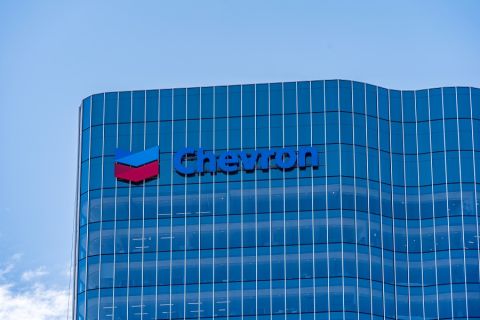
Speaking of risks of a global recession and the unique role the Federal Reserve plays in determining the course of the U.S. economy and abroad, KPMG Chief Economist Diane Swonk shared worries of moving from an era of abundance to an era of scarcity. (Source: Hart Energy, Shutterstock.com)
HOUSTON—KPMG Chief Economist Diane Swonk delivered sobering remarks recently.
Dressed in black, she joked about her request that alcohol be served before her luncheon keynote at the firm’s Global Energy Transformation Conference last week, saying “You’re going to need it afterward.”
Moments later The Federal Reserve increased its benchmark interest rate again—this time by three-quarters of a percentage point, sending it to a range of 3.75% to 4%.
“The Fed feels they have to do it and every other central bank in the world has to do it. They’re doing it at the same time, and it’s amplifying itself around the world,” Swonk said.
“What you worry about is that rate hikes here ricochet around the world and return to shoot ourselves in the foot. You don’t want a worse recession than you need to derail inflation.”
Speaking of risks of a global recession and the unique role the Federal Reserve plays in determining the course of the U.S. economy and abroad, Swonk shared worries of moving from an era of abundance to an era of scarcity. This is as the world continues to rebound from the pandemic, struggling with supply chain issues as geopolitics impact energy flow and the pace of the energy transformation.
The economy, she said, is more prone to boom and bust cycles as well as bouts of inflation and interest rate spikes. However, she believes a more measured approach in rate hikes is forthcoming as labor market conditions appear to loosen.
CEOs, including some heads of energy companies, are bracing for a recession, according to results from KPMG’s 2022 CEO Outlook.
Results from the firm’s outlook revealed 86% of those surveyed believe there will be a recession in the next 12 months, and 76% say they have plans in place to address it. Most CEOs are already adjusting or planning to adjust risk management procedures, eyeing global economic growth over the next three years.

Making adjustment
Recession risks and higher interest rates are prompting some energy companies to better manage costs as they look to add longer-term value. This includes NextEra Energy Resources, the clean energy unit of NextEra Energy.
“This is a great time to focus on how do we take advantage of the opportunity to decrease costs at the same time when you need to improve your business,” Rebecca Kujawa, CEO and president of NextEra Energy Resources, said during a panel at the conference. “That’s a pretty exciting opportunity to be able to realize, and I think that’s the key thing.”
Kujawa pointed to clean energy as a way for companies to lower costs in manufacturing, logistics, transportation, going beyond what she called the strategic imperative of needing to save the planet.
“You can actually can improve your business value proposition,” she said, adding clean energy’s ability to lower costs is an important part of the conversation.
Kujawa called the clean energy space “a terrific place to be, even with the higher cost of capital in the marketplace.”
NextEra Energy plans to invest between $85 billion and $95 billion between 2022 and 2025, growing many parts of its business.
Speaking on the current interest rate environment, Kujawa said financing in a rising interest rate environment is different than in a declining or exceptional low-interest rate environment.
So, NextEra is taking different steps than it had in the past to lock in interest rates. The company said earlier this month it had “$15 billion worth of interest rate hedges in order to lock in what we think are attractive rates today to enable us to continue to invest capital going forward,” she said.
“We need to make sure that we’re thinking holistically with the investment community, helping them understand how important it is to put their money where their mouth is, supporting the investment goals long term,” Kujawa said. “For us, we’ll also continue to price our renewable projects appropriately given the cost of capital.”
Finding support
The Inflation Reduction Act (IRA) could also help with higher interest rates, specifically loan guarantees available through the Department of Energy (DOE), said Jennifer Holmgren, CEO of LanzaTech, a carbon recycling technology company.
The IRA includes about $11.7 billion for the DOE’s Loan Programs Office to support issuing new loans and an additional $40 billion worth of loan authority for eligible projects eligible for loan guarantees.
Regina Mayor, global head of clients and markets for KPMG, added the firm is working on many financing ideas, including one on public-private funding with World Economic Forum.
“The EU and other countries have committed vast amounts of money to drive the transformation,” Mayor said, adding they are looking for ways to “derisk some of the debt,” encourage more private participation and better leverage how public money spent.

In addition to loan programs, the DOE offers grants and other funding opportunities.
“I think one of the good things about the DOE grants is that they’re really incentivizing us to work together so that collaboration comes through,” added Shell USA President Gretchen Watkins. “They’re not looking to award a grant just to Shell or just to NextEra.”
The agency looks to bring together companies, communities and academic institutions, “so we’re forming very unique partnerships to look at applying for these grants,” she said.
When it comes to incentives to accelerate the push toward lower carbon energy and renewables, “the stars are in alignment,” Swonk said.
Though there have been some interim obstacles following Russia’s invasion of Ukraine and rising coal demand, Swonk said she thinks renewables will accelerate. Then, she warned of what could be the next economic bubble: energy transition and climate change investments.
The energy transition, or energy transformation as some call it, will accelerate after a setback, according to the economist.
The private sector alone has pledged about $130 trillion to combat climate change, she said, adding that’s amplified when governments are added.
“They’re going to bet on a lot of things that aren’t actually ready,” Swonk said. “Every single major technological change we’ve ever had from railroad to the internet, there’s [been] a bubble. People lost their shirts and then we got proof. … But I think we’re finally thinking about things in a more holistic way, which is the only way to do it. You can’t just flip on a switch.”
Recommended Reading
Chevron Hunts Upside for Oil Recovery, D&C Savings with Permian Pilots
2024-02-06 - New techniques and technologies being piloted by Chevron in the Permian Basin are improving drilling and completed cycle times. Executives at the California-based major hope to eventually improve overall resource recovery from its shale portfolio.
Seadrill Awarded $97.5 Million in Drillship Contracts
2024-01-30 - Seadrill will also resume management services for its West Auriga drillship earlier than anticipated.
TotalEnergies Starts Production at Akpo West Offshore Nigeria
2024-02-07 - Subsea tieback expected to add 14,000 bbl/d of condensate by mid-year, and up to 4 MMcm/d of gas by 2028.
Well Logging Could Get a Makeover
2024-02-27 - Aramco’s KASHF robot, expected to deploy in 2025, will be able to operate in both vertical and horizontal segments of wellbores.
Shell Brings Deepwater Rydberg Subsea Tieback Onstream
2024-02-23 - The two-well Gulf of Mexico development will send 16,000 boe/d at peak rates to the Appomattox production semisubmersible.






